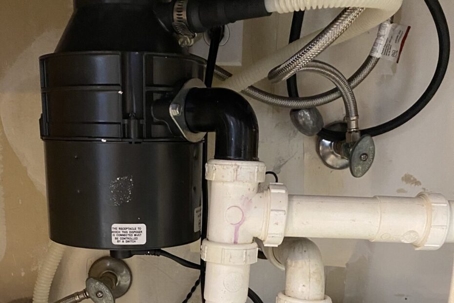Fast Solutions for Fixing a Dripping Waste Disposal Unit
Fast Solutions for Fixing a Dripping Waste Disposal Unit
Blog Article
We've encountered this article pertaining to Garbage Disposal Leaking From Bottom down the page on the web and believe it made perfect sense to write about it with you on this page.

Garbage disposals are essential kitchen home appliances that help in taking care of food waste efficiently. Nevertheless, a dripping waste disposal unit can be an irritating and unpleasant problem to deal with. Thankfully, numerous leaks can be repaired quickly with a few simple steps. In this article, we will certainly discuss just how to deal with a dripping garbage disposal efficiently.
Introduction
Waste disposal unit are set up under kitchen sinks and are made to shred food waste into smaller items, enabling it to pass through the pipes system easily. While these gadgets are generally reliable, leaks can take place in time as a result of deterioration, loosened connections, or damages to the device.
Step-by-Step Guide to Fixing a Dripping Garbage Disposal
Switch off the Power
Prior to trying any type of repair services, make certain that the power to the waste disposal unit system is shut off to avoid the threat of electrical shock.
Find the Leakage
Recognize the precise area of the leakage and determine the cause
Tighten Connections
Make use of a wrench to tighten up any loosened links in between the disposal system and the pipes system.
Replace Seals or Gaskets
If the leak is due to worn seals or gaskets, get rid of the old parts and replace them with new ones.
Patching Cracks or Openings
For fractures or holes in the disposal device, usage epoxy or a suitable patching product to secure the damaged location.
Determining the Source of the Leakage
Before trying to repair a leaking waste disposal unit, it is essential to identify the source of the leak. This can commonly be done with aesthetic assessment or by performing straightforward examinations.
Visual Examination
Evaluate the waste disposal unit device carefully for any kind of indicators of water leak. Pay very close attention to locations around seals, gaskets, and connection factors.
Evaluating for Leakages
One way to check for leaks is by running water with the disposal device and checking for any type of noticeable indicators of leak.
Usual Sources Of Leaks in Garbage Disposals
Worn Seals and Gaskets
Seals and gaskets play a vital role in avoiding water from dripping out of the waste disposal unit. With time, these components can wear away, leading to leakages around the disposal unit.
Loose Links
The connections in between the waste disposal unit and the pipes system can come to be loose with time, causing water to leakage out during operation.
Fractures or Holes in the Disposal Unit
Physical damage to the waste disposal unit, such as splits or openings in the real estate, can likewise result in leaks.
Devices and Products Needed for Taking Care Of a Leaking Garbage Disposal
Before starting the fixing procedure, gather the necessary devices and materials, including a screwdriver, adjustable wrench, plumbing's putty, replacement seals or gaskets, and epoxy or patching product for repairing fractures or holes.
Checking the Garbage Disposal After Fixing
When the repair service is complete, check the garbage disposal by running water via it to guarantee that the leakage has been solved.
Preventive Maintenance Tips to Prevent Future Leakages
To prevent future leaks, it is vital to perform routine upkeep on your waste disposal unit. This consists of keeping it tidy, staying clear of putting non-food items or difficult items down the disposal, and occasionally looking for leakages or other issues.
Final thought
To conclude, dealing with a dripping waste disposal unit is a reasonably straightforward process that can be completed with standard devices and products. By following the steps described in this article and practicing precautionary upkeep, you can keep your waste disposal unit in good working problem and avoid pricey repairs in the future.
HERE’S HOW TO FIX YOUR GARBAGE DISPOSAL
WHAT TO DO IF SOMETHING IS STUCK IN YOUR GARBAGE DISPOSAL
If the impeller won’t turn, there’s probably something stuck in the disposal. It could be a steak bone or peach pit, although plumbers report pulling all sorts of inappropriate objects out of disposals, such as bottle caps or aluminum foil. Make sure power to the disposal is off, and look inside to see if you can see the source of the jam.
Never stick your fingers in a disposal. Pull out anything you see with tongs or pliers.
If the disposal still won’t work, it may be time to call a plumber or consider buying a new disposal. GEM Plumbing & Heating is here for all of your garbage disposal needs.
WHAT TO DO IF YOUR GARBAGE DISPOSAL DRAIN IS CLOGGED
Take everything out from underneath your sink and put a bucket or other container under your disposal to catch any water that drains out. Disconnect your disposal from the power supply. If it’s plugged into a wall outlet, unplug it. If it’s hardwired into an electrical box, go to the electrical panel and turn off the breaker for the disposal. Pour ¼ cup of baking soda into the drain, followed by ½ cup of white vinegar. Give the solution a few minutes to fizz and do its work. Look into the disposal with a flashlight to see if you can see an object that might be causing the clog. If you see it, remove it using tongs or pliers. MORE TIPS ON DEALING WITH A CLOGGED GARBAGE DISPOSAL
Never use drain cleaner in a garbage disposal. It can damage the plastic parts inside the disposal. You can also be splashed with the caustic liquid while working to clear the clog. Beware! Never stick your fingers into a garbage disposal. Trust us — not a good idea. In many instances, your dishwasher drains through your garbage disposal. This allows the disposal to grind any large food particles that may be drained out of your dishwasher. There are some jurisdictions, however, where the plumbing code prohibits such a connection. WHAT TO DO WHEN YOUR DISHWASHER DRAINS THROUGH THE DISPOSAL
Run some water in the sink so your plunger has at least a ½-inch of water to create a seal and plunge vigorously up and down several times. You may need to repeat this several times. Run hot water down the drain to clear any residue that remains.

Do you really like reading up on Why Is ? Post feedback directly below. We'd be interested to know your opinions about this page. We are looking forward that you visit us again in the future. Sharing is good. Helping others is fun. Thanks a lot for going through it.
Schedule And Pricing Report this page